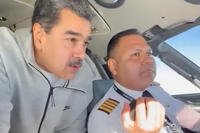The Air Force is investigating recent lower-category aviation accidents to determine whether there is a larger trend looming, a top general said Monday.
"What's been trending up and was reported was our 'Class C' mishaps, or our lower category mishaps. Lower dollar figure, but still a concern to all of us," said Air Force Vice Chief of Staff Gen. Stephen "Seve" Wilson.
"We've got our safety professionals digging into it, and seeing if there is a noticeable trend that we have in our Class C mishaps," Wilson said during the Future of War conference hosted by New America and Arizona State University.
Wilson's comments come after the Military Times published an in-depth report showing that military aviation accidents have increased exponentially over the last five years.
Related content:
- Thunderbirds Member Killed in Nevada Crash Was Former F-35 Test Pilot
- Major Exercise Canceled After Military Grounds US Aircraft in Djibouti
- USAF Short About 200 Maintainers, Pilot Training Continues: SecAF
Military Times reports 133 service members have been killed in aircraft mishaps since fiscal 2013, classified as "Class A" accidents. Class A mishaps include fatalities, severe damage totaling millions of dollars, or a complete loss of the aircraft.
The U.S. Navy had the highest increase among the services, an 82 percent hike in that timeframe from Class A through Class C mishaps, Military Times said. The service's spike was largely due to Class C mishaps, non-fatal accidents sustaining between $50,000 to $500,000 worth of damage to the aircraft, that still pose a risk to readiness and could lead to injury or lost work days.
The Air Force too saw an increase in Class C mishaps, according to a separate Air Force Times report. The service's mishap statistic rose 16 percent overall between 2013 and 2017.
"Any Class A accident is one too many," Wilson said, adding, "The safest year ever was 2014, and 2017 was our second safest year, so our Class A mishaps have been trending down."
Wilson said the latest accidents provide greater impetus for fixing the service's readiness shortfalls, which have been impacted by high operational tempo, sequestration effects and general maintenance shortages.
"We're intensely focused on improving readiness," he said. "We've brought together a team, about 50 people. We sequestered them in the Pentagon for about six weeks, and we looked at readiness through the lens of, 'What can we do to drive the readiness of the Air Force faster?' "
He added, "We think we can do it faster. We're looking at how to target specific squadrons with the right people, with the right experience mix, with the right flight hours and infrastructure to be able to support pacing [the] squadrons."
Over the last week, the Defense Department has seen a range of aviation accidents, the most recent occurring Friday when an Army AH-64E Apache helicopter from Fort Campbell, Kentucky, crashed during a night-training mission, killing two on board.
Officials on Sunday identified the soldiers as 37-year-old Chief Warrant Officer Ryan Connolly and 28-year-old Warrant Officer James Casadona.
An Air Force Thunderbird pilot was killed Wednesday after his F-16 Fighting Falcon crashed at the Nevada Test and Training Range. Maj. Stephen Del Bagno was participating in a routine training flight when the crash occurred at approximately 10:30 a.m. local time, the Thunderbirds said in a release last week.
Meanwhile, the Navy temporarily grounded military flights in Djibouti and canceled a major exercise days after it began, following two aviation accidents in the theater.
An AV-8B Harrier jet from the 26th Marine Expeditionary Unit crashed during takeoff at 4:10 p.m. local time after taking off from Ambouli International Airport on April 3.
During the same exercise, a CH-53 Super Stallion helicopter from the 26th MEU sustained minor structural damage about two hours later during a landing near Arta Beach.
Separately in the U.S., a CH-53E helicopter crashed March 2 during a training mission in southern California, killing all four on board.
-- Oriana Pawlyk can be reached at oriana.pawlyk@military.com. Follow her on Twitter at @Oriana0214.














